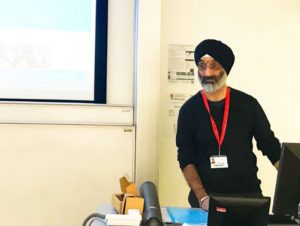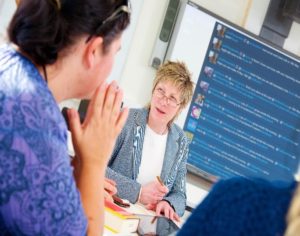#SWTech – An Introduction and History of the Online Group
Editor’s Note: This blog post was written by the following users of the #SWTech Community – Melanie Sage, Assistant Professor of Social Work at the University at Buffalo; Laurel Iverson Hitchcock, Associate Professor of Social Work at the University of Alabama at Birmingham: Jonathan B. Singer, Associate Professor of Social Work at Loyola University and founder of the Social Work Podcast; and Nancy J. Smyth, Professor & Dean at the School of Social Work at the University at Buffalo.
This is an introduction to #SWTech, an online network of social workers interested and engaged with technology for social good. Our goal is to help individuals new to #SWTech learn about the norms, history, and general merrymaking within the community. This statement can also service as a resource to send people who are interested in learning more about #SWTech.
Description
#SWTech is a hashtag used by people and groups interested in the intersection of social work and technology. People use #swtech primarily on Twitter, but the hashtag is occasionally used on other social media platforms such as Facebook or Instagram. This hashtag is used in tweets and other posts on social media to share about such topics as:
360-degree immersive video apps: Why you should create meaningful research-based digital resources to engage learners

Editor’s Note: Dr. Tarsem Singh Cooner is a Senior Lecturer in the Department of Social Work and Social Care at the University of Birmingham. In this post, he describes why and how he developed 360-degree immersive video apps to create engaging learning opportunities for students. Additionally, his work shows how digital tools can be used to creatively disseminate research findings to practitioners. Dr. Cooner tweets at @Akali65. You can also email him at t.s.cooner@bham.ac.uk.
The background
Quite recently I was lucky enough to be part of a fantastic research project exploring factors that can either enable or create barriers to effective child protection social work. Our project had collected a lot of data that we were convinced could have a really positive impact on child protection services. To disseminate our research in a more accessible, meaningful, situated and impactful way, I led an initiative within the team to create a set of 360-degree immersive video apps that social work students and practitioners can download onto their smartphones via the iTunes and Google Play Stores. Using their phones with easily accessible 360-degree headsets (like Google’s Cardboard) they can become ‘immersed’ in our work through recreated scenes from our research experiences.
Preparing social work students for the licensure exam: An online intervention

Editor’s Note: Stephen Cummings is a Clinical Assistant Professor in the School of Social Work at the University of Iowa, where he works primarily distance education. In this blog post, Stephen shares how he converted an onground licensure prep review course into an online course with live sessions to increase accessibility of the content for students. You’ll also find a link to his published work about the course in the post. You can find Stephen on Twitter at @spcummings.
Over the past several years, I have been providing an online study session to help MSW students prepare for the Masters-level licensing exam. The online intervention came out of a practical necessity.
A brief history: In the spring of 2013, several students approached my school’s faculty with a concern. Iowa, our jurisdiction, allows students to sit for the graduate level licensure exam during their final semester. As long as a student is in good standing (meaning they are not on academic probation and are taking the requisite course work for graduation), that student can be granted permission to sit for the exam prior to graduation day. This arrangement is intended to help close the gap between graduation and full employment, specifically in an environment where licensure is required. The students asked if the school could provide assistance is exam preparation.
Your Devices are Welcome!: How to Handle Technology in the Social Work Classroom

Editor’s Note: Dr. Stephanie Hamm is an associate professor of social work in the School of Social Work at Abilene Christian University in Texas. In this blog post, she shares how mobile devices and other forms of technology are incorporated into her social work class sessions. You can follow her on Twitter at @drHammsj.
Many years ago, when I was a social work student, I learned effective ways of working with people, what to do, and how to take care of myself. Back then, we did not rely on the Internet, rather, we relied on books and articles, and the expertise of our teachers, field instructors, and practitioners in the field. We often relied on the policies of the organization. Today, in my classroom, students can check names and dates, statistics and new interventions in no time at all, using their phone. I once had a student fact-check everything I said in class! Students know when an instructor is bluffing and faking, so why not tap into their curiosity and easy access for the purpose of creating a classroom in which students are not just consumers of course content, but co-creators. I tell my students that they are responsible for their knowledge as well as their classmates’ knowledge.
I use and encourage technology and devices in my classes to find information that is quickly changing. For example, my content for a class session can discuss social theory on the changing American demographics, and students can quickly find actual numbers that define and operationalize that changing demographic.
Consciously Connecting and Proactively Collaborating: The CoActEd Learner Mapping Tool in #SocWorkEd

Editor’s Note: Amanda Taylor-Beswick is a Senior Lecturer in the School of Social Work, Care and Community at the University of Central Lancashire. She is also an author of the book, The LearningWheel Book, whichprovides educators with a model for helping students and practitioners develop digital literacy skills. In this blog post, Amanda describes one of the tools from her book, the CoActEd Learner Mapping Tool. She tweets at @AMLTaylor66.
From the moment a social work student steps into the educational environment, they are engaged in a socialising process that involves exposure to, familiarisation with, and the development of professional norms. Through this carefully crafted learning experience a student’s Professional Learning Network (PLN), amongst other things, begins to form; professional relationships with academics, with practice partners, with practitioners and with student peers are built. This professional network is primarily local, largely institutional and generally geographically bound. However, digitisation means that the professional network no longer needs to be so rigid, so limited or so confined. The availability and affordances of social technologies (those that are #GDPR compliant) offer opportunities for social work students to connect outside of their direct or more natural community of learning. They can engage with the global social work community which, in previous times, may have been out of reach. The use of a medium through which to map and to therefore build connections forms the basis of this blog.
‘App’- lying the digital in social work… Or why we should not be teaching the same way for 20 years

Editor’s Note: Denise Turner, PhD is a senior lecturer in the Department of Social Work at London Metropolitan University. Her research interests focus on the innovative use of digital technology in teaching and practice. In this blog post, Denise shares her collaborations and process when developing an app for mobile devices for social work students and practitioners. You can follow Denise on Twitter at @DeniseT01.
The Background
Recently, my first draft of an article focussed on creating digital resources to update social work education, was returned with the question, ‘Does it really matter that this has been taught the same way for over twenty years?’ After the inevitable, slightly nonplussed reaction to article reviews, I was forced to give this question some considerable thought. Certainly, Steve Wheeler, whose work on e-learning I hugely admire, counsels against using technology simple because it is ‘new and shiny’ (Wheeler, 205, p. 7). In response to the reviewer, I had to ask myself if this applied to me. Was this what I was doing? Simply jumping on a digital bandwagon because it was trendy? Certainly, my ever-advancing years and my own lack of digital acuity suggested this might be the case. As the old adage suggests, was I one of those who taught because I couldn’t do? On reflection, I returned to the original source of the problem in order to try and find an answer.


